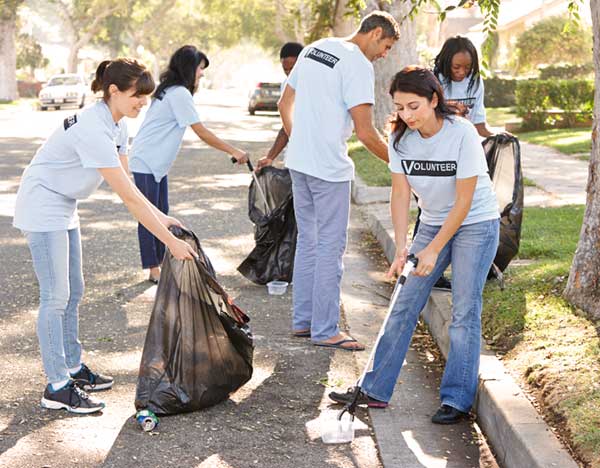 Several cities have come up with creative strategies to persuade the public to litter less and use trash receptacles more
Several cities have come up with creative strategies to persuade the public to litter less and use trash receptacles more
Cities everywhere are often faced with an ongoing battle to eliminate and prevent litter and encourage more people to use trash receptacles on streets, sidewalks, transit stations, parks, and other public areas.
Whether it's accidental in nature or out of carelessness, discarded bottles, wrappers, containers and other trash are a major eyesore and can affect the appearance and cleanliness of a city.
Looking at the seriousness of a growing litter problem has led many cities to take a fresh approach to anti-littering campaigns. These campaigns vary in nature, but they all have eye-catching elements and unique angles to capture public interest and put a stop to trash troubles.
Learning more about the successful littering campaigns used by cities around the world can provide the inspiration needed to help your city develop its own anti-littering campaign and conquer trash once and for all.
Toronto uses trash talk to target litterbugs
The city of Toronto decided to take aim at litterbugs with direct messaging that reminds people that "Littering says a lot about you."
The images in the Livegreen Toronto campaign feature wrappers, bottles, and other pieces of trash with the brand names cleverly arranged to spell out different words that characterize litterers.
These labels include dumb, lowlife, selfish, and pig - to name just a few. The unique visual imagery catches a person's attention as they try to figure out which bag of chips was used to spell a word - but the deeper message that littering reveals a character flaw or groups a person with those who are stupid or lazy lasts much longer.
The sentiments may sound harsh, but the city has met with a lot of support for the campaign that is designed to make people think about what their actions say about their character.
Jersey City Uses Youth to Limit Litter
Jersey City, N.J. knew it needed a partner in taking on its trash problem. The city developed a campaign called 'Stop the Drop' - then looked for 180 young people to participate in a two-month summer clean-up program.
The teens and young adults work Monday through Saturday from 9 a.m. to 2 p.m. to collect trash and debris from Jersey City streets. The program beautifies the city, but also provides summer employment opportunities to youths while teaching them to take pride in the appearance of the community.
By involving young people in the anti-littering campaign, Jersey City is helping the city's next generation to learn responsibility when it comes to disposing of trash in proper trash receptacles, how to work as part of a team, and the value that comes from working towards a common goal.
But young people aren't the only ones that are invited to participate in the Stop the Drop campaign. Other residents of Jersey City are encouraged to take a pledge to spend 10 minutes a day cleaning up the city.
Limiting litter is a community-wide effort and this campaign unites Jersey City in a way that is bringing positive results for young and old alike.
Facing litter in Hong Long
As a mega-metropolis of China, Hong Kong is no stranger to the litter problem. Littering and marine debris are a perplexing problem in a city that disposes of 15,000 tons of trash every day.
The Hong Kong Clean Up organization looked for a way to call attention to the individual responsibility that every person has to dispose of trash responsibly. The result was a campaign called "The Face of Litter."
This unique anti-littering campaign used DNA phenotyping to create a digital representation of the faces of supposed litterers. These images were then used in displays at transit stations throughout the city.
The catch is that the faces didn't belong to actual litter offenders. Instead, the DNA was collected from a group of volunteers. The idea, however, was to show the public that littering may seem like an anonymous act - but the offender is still guilty. And while the city currently is using DNA phenotyping to identify real litterbugs, the campaign included the warning: "Don't let it be your face."
Persuade people to use trash receptacles, not the ground in your town
Does your city face a litter problem? Whether large or small, cities are constantly looking for ways to curb trash. Getting to the end-goal of litter reduction is really a three-step process. It includes:
- Eliminate existing litter - This is important because if streets are full of debris, people are more likely to add to it. If sidewalks or parks are already dirty, they may reason that one more piece of trash won't make a difference. Add more trash receptacles to busy area. Be sure to empty trash receptacles as soon as they are full - studies show that litter on the ground encourages more litter. How many times have you seen a full trash can surrounded by a mound of garbage on the ground surrounding it?
- Promote litter prevention - To really change the behavior of people, you need to influence their thinking. Using litter prevention campaigns, like the ones implemented by Toronto or Hong Kong, can make people think twice about whether or not they want to be identified as a litterer, or someone that is lazy. Instill that little feeling a guilt when they fail to use a trash receptacle in a public place or commercial garbage cans at businesses.
Work to develop clever and eye-catching campaigns that will raise awareness of the issue and also leave a lasting impression on residents and visitors alike. The best campaigns also spark conversation, adding to the reach and impact of the message.
- Reduce future litter - Once you've cleaned up existing trash, take steps to reduce future litter. Some suggestions include reducing single-use plastics and making trash and recycling receptacles plentiful and accessible. In fact, Disney found that people generally won't walk more than 27 feet to throw something away. So the more frequent and accessible trash receptacles are, the more likely people are to use them instead of littering.
Another note about reducing litter is the importance of preventing what could be termed "accidental littering." If trash or recycling receptacles are too full or not windproof, properly disposed of trash can quickly morph into litter. Choose durable commercial garbage cans with a narrow opening or push door lid that will keep trash from being blown around, and make sure that it is regularly emptied.
Los Angeles recently added 5,000 more trash receptacles to fight trash in their town.
It can be done. Conquering litter in your city just requires creativity, commitment, and the right tools.
Note: The Park and Facilities Catalog has a wide range of trash receptacles to help you meet the practical needs of your community and commercial trash cans for your business.
 How cities are tackling the growing litter problem
How cities are tackling the growing litter problem


